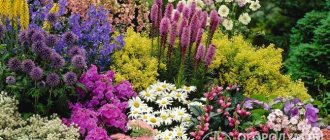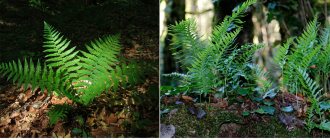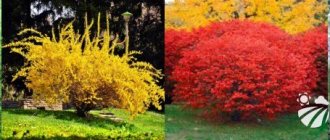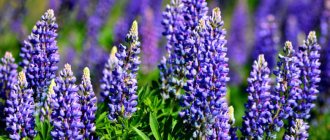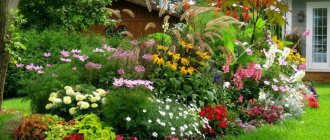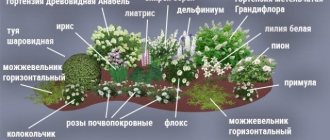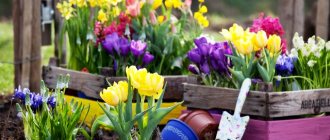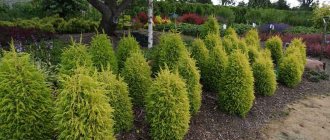Not a single owner of a personal plot can boast of its full illumination during the day. A house, outbuildings, fences, trees inevitably create shade, and you want to decorate every corner with floral and decorative foliage crops. Shade-loving plants for the garden will do the best job of decorative landscaping in secluded places.
Discreet flowers and lush foliage create a feeling of peace, promote rest after the heat or from bright summer colors, relaxation and contemplation
Primrose
Wonderful low-growing perennial primrose and its hybrids thrive in the shade. They can grow at the front edge of the flower bed, in the shade of taller, sun-loving flowers. The height of shade-loving primroses is 10 - 20 cm, of various colors. The most interesting types of primroses to grow are auricular ones. Its flowers are double, with various rims. Primrose is difficult to grow at home from seeds, so most often they propagate by dividing old bushes, or purchase new ones. This flower is one of the first to bloom in the garden and delights with its flowering from April to May.
Lungwort
These flowers that love shade are familiar to many from childhood. It is the one that grows in the shade of the forest, and if you taste the bed of the peduncle, it will taste sweet. This is where the name of this color comes from. The leaves of this plant have white spots, the flowers change color from pink to blue. There are varieties with whole green leaves and varied flower colors. Plant height is 30 - 40 cm. It can grow strongly and is classified as ground cover flowers, since the flowers can bush a lot. Lungwort is divided and replanted once every 3 years. Refers to spring flowering plants. Flowering time: April - May.
Trees
European beech
Slightly moist nutrient soil is best suited for growing beech. It can be grown in a shady area.
Common ash
Ash is a fast-growing tree that is resistant to polluted air. Nutritious soil is best, but can also grow in soil of average fertility. To plant an ash tree, you can choose a semi-shaded area.
Mountain ash
The relatively low and stable mountain ash is a shrub or tree. This shade-loving crop is undemanding to the quality of the soil. In the summer-autumn period, the branches of the bush are decorated with spectacular red-orange berries.
Elm
Mountain and European elms prefer to grow in nutritious and moist soil. They are highly resistant to low temperatures and shade-tolerant. Susceptible to Dutch elm disease.
Canadian hemlock
Canadian hemlock is a coniferous shrub or tree. It grows best in areas with high humidity and nutritious soil. Dwarf varieties are grown in small garden plots. As a rule, they are planted on shady rockeries or ridges.
Rogersia
It is similar to ornamental rhubarb and can grow in a shady, moist border. The leaves are palmate on long petioles, the flowers without petals are collected in fluffy panicles. It is a perennial and is propagated by dividing bushes in spring or autumn.
These are tall flowers that love shade in the garden, growing up to 1.8 m in height, compact plants up to 1 meter. An excellent plant for decorating country fences and buildings.
Tips for caring for Rogers:
- water abundantly during drought;
- In autumn, cut at the root.
Medium-sized perennials
The group of medium-sized ones includes aquilegia, aconite (fighter), astilbe, bergenia, brunera, dicentra, kupena, hosta, and rogersia. The tallest ones do not exceed 1-1.2 m.
Aquilegia (catchment)
The genus Aquilegia (Runcup family) includes more than 120 species.
I remember that as a child we really loved collecting aquilegia in bouquets (we were attracted to unusual flowers with a variety of colors, often two-tone), and we also barbarously dismantled the flower itself, tearing off the spurs, which looked like either oriental slippers or glasses. But the plant is poisonous, especially the seeds.
The catchment blooms in May-June. Looks especially good under a canopy of trees. Propagated by seeds and division of the bush.
The catchment got its name because the flower corollas fill with water after rain or dew early in the morning.
Kupena
Kupena officinalis (fragrant) is a perennial rhizomatous plant from the Asparagus family. Its oblong leaves with pronounced veins are arranged on an arched stem alternately, in two rows, and below them, like drops, hang white tubular flowers up to 3 cm long, in place of which blue berries ripen at the end of summer. The plant is not only decorative, but also valuable in medicinal and honey production. Propagated by dividing rhizomes. Planting is best done in the fall.
It is necessary to grow kupena in the local area with caution: the plant is poisonous, especially the fruits
Hosta (function)
Speaking about shade-loving crops, is it possible to ignore the queen of shade - the hosta?! It is not valued for its flowering, although its inflorescence, a raceme consisting of pale lilac flowers, is distinguished by its grace and beauty. It achieved mega-popularity thanks to its large rosette of foliage and various variations in color, shape and size, and surface texture of the leaf blades. It turns out that breeders have bred about 12 thousand varieties!
Hosta can grow both in the shade and in the light. The color of the leaves of some representatives of the culture can change depending on the amount of solar radiation. Thus, blue views turn green in the sun. Yellow varieties, on the contrary, are good in the sun, and in the shade they take on a “chartreuse” (yellow-green) color.
Plants are sold with a closed root system; they can be easily grown from seeds or obtained by dividing the mother bush, which is best done in the spring. In the first year, the hosta needs to be provided with sufficient watering and fertilizing with complex mineral fertilizers.
This surprisingly unpretentious plant adapts well to dense shade and to any type of soil, and can easily tolerate replanting.
At first, hostas grow slowly, so the gaps between them are usually filled with annuals. At my entrance (northwest side) I planted three hostas in the foreground, and as neighbors - heuchera, ostrich, and reed canary grass. Color spots are provided by low shrubs of Japanese spirea and hydrangea, Przewalski's buzulnik, cream and pink astilbes, violas, daisies, forget-me-nots, and coleus. Marigolds also tolerate shade, but do not develop as powerfully as in the sun.
Ferns
When designing a shady recreation area at your summer cottage, be sure to pay attention to ferns. Modern gardeners value them for the appearance and grace of their fronds (fronds are leaf-like organs). Plants can grow even in dark places and love watering. They look good alone, in groups, near bodies of water. They need soil made from a mixture of leaf soil, peat and sand. Ferns reproduce easily by offspring. They can be brought from the forest in spring or autumn and planted in your garden. The main thing is to carefully dig up the roots, preserving the earthen lump.
Commonly grown ostrich grass (pictured), male shield grass, female stump grass, and Brown's multirow
Cereals
Cereals are well-known lovers of open sunny spaces, but among them there are species that grow well in partial shade: reed grass (canary grass), blue molinia, spreading boron, green grass, turf pike, medium-sized shaker grass, meadow foxtail .
Reed sedge (variegated sedge, falaris) is decorative, unpretentious and capable of growing very quickly
Smilatsina
A border perennial with arched stems crowned with racemes of tiny star-shaped flowers. Fragrant flowers are often replaced by red berries. This is a plant for a wooded corner of the garden that is best left undisturbed. And if you are deciding which flowers grow in shade, and forest-like shade, it is definitely smilacina, which grows quickly, forming beautiful ornamental bushes and creating a soulful landscape design for the area.
The height of the flowers is 60 - 90 cm. The best species for growing in the garden is Smilacina racemosus, which forms large bushes. Flowering period from May to June.
Tips for caring for smilacina:
- shading is required;
- in spring the soil needs to be mulched;
- propagated by dividing bushes in spring.
Examples in landscape design
In partial shade, the most original compositions in all natural tones are good. Ready-made compositions by landscape designers will help you add bright colors to the dark corners of the garden.
The diagram of a flower garden in partial shade, where plantings of knotweed, astilbe and favorite hostas are visible, is a clear example for gardeners.
The second diagram also shows flowers familiar to us. A flower bed with mock orange, foxglove, lupine, bergenia and mantle can be placed near the fence.
Even in deep shade there is room for flowers. Here you can see how delicate blue flowers are visible among the lush greenery.
The flowerbed does not have to be round. The unusual shape will add zest to your garden.
With a little effort, using different shade-loving flowers, you can create chic compositions. If you have suggestions for creating unusual flower beds, we will be happy to present them to our readers. Share with us in the comments.
Tiarella
Above the wintering leaves, which turn bronze or red in the fall, racemose inflorescences of small fluffy flowers rise in the summer. Grows well under trees.
Perennial. Flowering time depends on the species. Tiarella Verri blooms from June to September and does not spread. Tiarella multifolia blooms in May - June. According to the duration of flowering, these are long-blooming flowers. The height of the plants is average, 30 - 50 cm. These garden flowers, blooming in the shade, do not tolerate direct sun and lack of moisture.
There is one feature for all flowers in the shade - all shade-loving flowers need to be planted on humus-rich soil.
Dicentra
An excellent border perennial and rock garden perennial with a plant height of 30 cm. Wonderful medallion flowers hang from arched peduncles above the feathery foliage. These shade flowers need a protected place to grow: young leaves suffer from cold winds. These flowers can be planted in the shade of trees. Flowering time is from May to June. Color: pink, pinkish-lilac, red.
Dicentra care advice:
- The roots of the plant do not lie deep, so the soil around the stems is not loosened.
Ferns
Ferns thrive in a shaded area, but they need moderately moist soil. The following types of ferns are most popular among gardeners:
- male shieldweed;
- common millipede;
- the bladder is fragile;
- common ostrich;
- multirow spinous.
Bladder brittle
Common ostrich
Brittle bladderwort
What plants to plant in shady areas
Khosta
Hosta is grown for its gorgeous foliage. These are decorative leafy garden flowers in the shade - the pride of any gardener. The foliage has longitudinal stripes of yellowish or white color, bluish-green. Hosta blooms in paniculate inflorescences, with numerous bell-like flowers that bloom in June - August. Grows well in partial shade, under trees. Belongs to border perennials.
Propagated by dividing bushes and nests in the spring. Plant height 50 cm.
Hosta care tip:
- add organic matter before planting;
- the soil where the hosta is planted should be well-drained;
- protect the plant from slugs.
Aquilegia
Aquilegia
A plant that can amaze anyone with its variety of species and shades. It blooms in June, but when the faded flower stalks are removed, it is capable of re-blooming. I also really like the foliage of Aquilegia. A bright bush of openwork leaves is decorative even outside the flowering period. Small aquilegia flowers are distinguished by their original shape, delicate shades and discreet charm. Aquilegia can give a shady flower garden a completely different sound, transforming it into the bright palette of an artist.
Related article: Aquilegia: growing and caring for perennials for the garden
Violet
There are different types of violets, which are also called pansies. But, if you are choosing a list for the garden, from the category of which flowers bloom in the shade, then you need a perennial violet. This:
- Fragrant violet Viola odorata - 10 - 15 cm. White or blue color. Fragrant. Flowers with a diameter of 2 cm. Blooms in May.
- Horned violet Viola cornuta - 20 cm. Lilac. Blooming all summer from May to September.
- Labrador violet Viola labradorica - 10 cm. Violet - blue. Blooms in spring and early summer.
- Yellow violet Viola lutea and two-flowered Viola biflora - 10 cm. Yellow. Blooms in May - June.
Perennial violets definitely need shade. Faded inflorescences should be removed regularly. The plant is protected from slugs. During drought, watering is necessary.
Phloxes
There are perennial and annual phloxes. And both types are the kind of flowers that love light shade. They bloom profusely in the second half of summer. Dwarf perennial phlox species are grown in rock gardens.
Phlox blooms in inflorescences of small bell-shaped flowers, the total size of the inflorescences reaches 10 cm in diameter. Flowers with rounded or pointed petals. More popular modern varieties such as Phlox Drummond 'Tapestry Mixed' are more compact and more vibrantly colored than older varieties. The height of perennial plants is 50 - 80 cm, annual phlox reaches 20 - 50 cm.
Phlox care:
- when planting, add organic fertilizers to the soil;
- in spring, the soil around the bushes is mulched;
- if necessary, tie up the stems;
- water moderately;
- at the end of autumn, perennial phloxes need to be cut off at the root.
Astilbe
Feels great in light partial shade on the site. Requires fertile soil. Therefore, before planting astilbe, you need to add organic matter. Spectacular paniculate inflorescences can be left on the bush until autumn. Pinnately dissected leaves often take on a copper tint in spring. During drought, plants need to be watered. There is a drought-resistant species - this is Chinese astilbe.
A fairly tall plant - 90 cm, can grow in the background or middle ground of a flower bed. Used as a border perennial and rock garden perennial. These flowers need to be planted in the shade.
Is a shadow always a shadow?
A flower garden in a shady place can be formed from plants of 2 categories:
- Shade-tolerant plants . Can tolerate lack of sufficient sunlight. They would be happy to grow in the sun, but they will also thank you for a place in a shady flowerbed. I am sure that these representatives are well known to you, for example, astilbe, columbine and viola.
- Shade-loving flowers and shrubs . They feel uncomfortable under the sun; their leaves burn and fade very quickly. These include various hostas, the fern family, and periwinkle.
Snowdrop
Bulbous primrose. Small graceful flowers are the harbingers of spring. It blooms in early spring, one of the first in the garden, in April - May.
The snowdrop is similar to the whiteflower, but it has three inner "petals" with green tips, and the outer three are pure white. A low-growing flower, about 15 - 20 cm in height. Loves humus-rich soil and light shade. These lovely flowers need to be planted in the shade.
Strawberries
A shade-loving groundcover plant grown for its flowers and berries. The characteristic trifoliate leaves can decorate a shady garden and create an atmospheric corner.
Strawberries grow quickly and can choke out weaker plants. It blooms in May - June, and the delicious and fragrant berries ripen at the end of June - July. Suitable for creating a herb garden. Plant height 10 cm - 20 cm.
Rules for building a shady flower bed
Before you start filling the flower bed, it is better to familiarize yourself with the simple rules for constructing a flower bed, which will help you avoid common mistakes.
- There is no need to try to fit all the variety of shade-tolerant plants into one flowerbed. It is better to focus on several types.
- When selecting decorative flowering plants, it is necessary to take into account the flowering time of each representative.
- We must not forget about maintaining heights and tiers. If the flower garden is visible from all sides, it is better to place tall flowers in the central part of the composition. If you plan to fill the space along a fence or wall, the background is filled with tall elements.
- To organize a shady flower garden, it is better to use a combination of decorative foliage with flowering elements.
- A win-win option in the design of any flower arrangement is a combination of horizontal lines turning into vertical ones. For example, decorative leaves of the hosta, located in a horizontal plane, go well with tall peduncles or towering stems of other elements of the flower garden.
Advice! If the flower garden is not planned to be fenced, the transition from the lower tier to the lawn can be smoothed out with the help of ground cover plants.
By following these simple rules, you can easily decorate your shady flower garden with a spectacular composition that will blend with the surrounding landscape and become its decoration throughout the season.
catchment area
Traditional columbines have white or blue flowers with short spurs. Nowadays varieties with long spurs, double varieties, and also dwarf ones for rock gardens have been bred.
These are flowers that love shade and bloom in the shade in the first half of summer, from May to June. For long-term flowering, you need to remove faded flowers and water abundantly during drought. They grow well in constantly moist and shady places.
They reproduce by seeds, which can be sown directly into open ground in the spring or by dividing overgrown perennial bushes.
Day-lily
Blooming in light shade, these flowers appear in midsummer, above rosettes of strap-shaped leaves on long stalks. Each flower lives only 1 day, but the flowering communication of the plant continues for many weeks.
An unpretentious, easy to grow plant. Requires watering during drought, can grow along the banks of reservoirs and along the house. Plant height is 90 cm. Flower color is yellow, orange, dark red. A perennial plant that reproduces by dividing bushes.
Begonia everblooming and begonia species with tubers
Begonia is an ever-blooming plant, usually grown as an annual that grows well in partial shade. The color of the round, fleshy leaves varies from pale green to chocolate brown. The size of flowers can vary from 2 to 15 cm. Color from white to almost black. When planting begonias, add compost to the beds. Planted at the end of June (not in May!) Begonia blooms, which loves shade from June to September.
Ivy
Almost every summer cottage could use climbing plants for the north side of the house. It is here that a deep shadow forms, little grows, and despite this, I really want to green up this particular part of the lot. There are not many climbing plants that can be planted on the north side of the house and they will do well there. This is exactly what the unpretentious evergreen vine, ivy, belongs to. Ivy does not harm trees or buildings and can grow wildly.
Plants for coastal areas with high humidity
The following plants are most often grown in shady coastal areas with high humidity:
- buzulnik;
- marsh marigold;
- loosestrife;
- point loosestrife;
- ivy;
- astilbe;
- hellebore;
- Siberian iris, Japanese, common yellow;
- European swimsuit;
- Tradescantia virginiana, Anderson.

